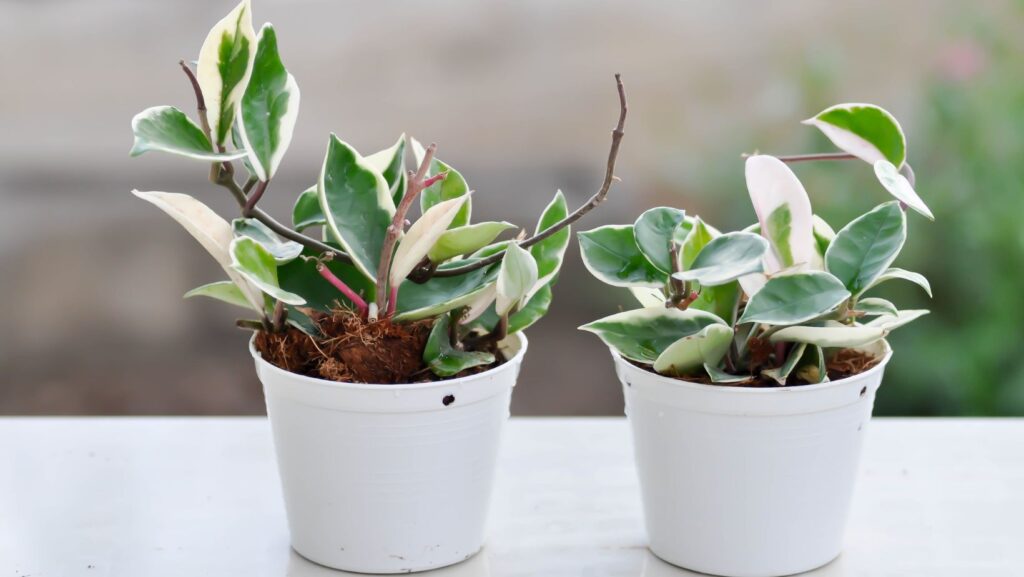Hoya plants, often called “wax plants” due to their thick, glossy leaves, are beloved by houseplant enthusiasts for their striking foliage and unique, fragrant star-shaped flowers. These plants are relatively low-maintenance, making them a popular choice for indoor spaces. However, like any plant, Hoyas require specific care to grow well and produce their iconic blooms. Whether you’re new to Hoyas or looking to improve your care routine, this guide will help you understand how to foster healthy growth and vibrant flowering in these stunning plants.
Contents
Table of Contents
ToggleUnderstanding Hoya Plants
Hoya plants are native to Southeast Asia and Australia, where they thrive in tropical climates. There are over 200 types of Hoya plants, with the most popular varieties being Hoya carnosa, Hoya australis, and Hoya kerrii. Each species has slightly different characteristics, from heart-shaped leaves to long trailing vines or upright growth habits. While they differ in appearance, most Hoyas share similar care requirements, which means you can apply many of the same principles to different species.
In their natural habitats, Hoyas are epiphytes, which means they grow on other plants and trees, using them as support without harming them. This gives insight into how they prefer to grow indoors. Replicating their natural environment as much as possible is key to helping them thrive indoors. Whether you’re growing a trailing Hoya in a hanging basket or training one up a trellis, understanding where they come from will give you a better sense of how to care for them.
Ideal Growing Conditions for Hoya Plants
Light is a critical factor in the growth and blooming of Hoya plants. These plants thrive in bright, indirect light, mimicking the dappled sunlight they would receive in their natural environment. Placing your Hoya near an east- or west-facing window is often ideal, but be careful not to expose it to harsh, direct sunlight for extended periods. Too much direct light can scorch their leaves, while too little light can lead to slow growth and reduced blooming potential.
In addition to light, temperature, and humidity play significant roles in the health of Hoya plants. They prefer temperatures between 65-80°F (18-27°C). Temperatures that are too low can stunt growth, while higher temperatures can dry the plant out too quickly. Humidity is equally important. Hoyas love humidity levels between 50-60%, so if you live in a drier climate or your home is air-conditioned, consider using a humidifier or placing a tray of water near the plant to increase the moisture in the air. This can be especially important during winter months when indoor heating systems tend to dry the air.
Watering Hoya Plants Correctly
Watering your Hoya plant correctly is crucial to its health. Hoyas prefer to be watered thoroughly but not frequently. The general rule of thumb is to allow the top two inches of the soil to dry out between waterings. During the active growing season in spring and summer, you may need to water more frequently, while in winter, when growth slows, you should reduce your watering schedule.

Water quality also matters. Hoyas are sensitive to the minerals in tap water, such as chlorine and fluoride, which can build up in the soil over time and harm the plant. If possible, use filtered or distilled water to keep your plant happy. Overwatering can be a significant issue for Hoyas, leading to yellowing leaves, mushy roots, and eventual root rot. Underwatering, on the other hand, will cause the leaves to wilt or shrivel. It’s important to find a balance that keeps the plant hydrated without sitting in excess water.
Feeding and Fertilizing for Optimal Growth
Like most houseplants, Hoyas benefit from regular feeding during their growing season. A balanced, water-soluble fertilizer is a good choice. You can also opt for a slow-release fertilizer if you prefer to fertilize less frequently. During the spring and summer months, when your Hoya is actively growing, fertilize every four to six weeks. Be cautious not to overfeed, as this can lead to fertilizer burn, which manifests as brown, crispy leaf edges and overall stunted growth.
During the fall and winter months, Hoyas enter a semi-dormant phase. At this time, reduce or completely stop fertilizing to allow the plant to rest. Overfeeding during this time can prevent the plant from blooming in the next season.
Pruning and Training for Bushy Growth
Pruning is an essential part of caring for Hoyas, especially if you want a fuller, bushier plant. Regular pruning encourages new growth and prevents the plant from becoming too leggy. To prune, simply cut back long, straggly stems just above a node. This will prompt the plant to branch out and grow denser. It’s also a good opportunity to remove any yellow or damaged leaves to keep the plant looking its best.

Hoyas are natural climbers and trailers, so supporting them is essential. You can use stakes, trellises, or hanging baskets to guide their vines as they grow. Training them to grow upwards or allowing them to trail downwards depends on your aesthetic preference, but ensuring the vines receive adequate light exposure is key for healthy growth.
Conclusion
Caring for Hoya plants requires attention to their specific needs, from light and water to temperature and humidity. By replicating their natural environment and providing the right conditions, you can encourage healthy growth and eventually enjoy the reward of their unique, fragrant blooms. Whether you’re a seasoned plant enthusiast or just starting, Hoyas offers a beautiful and rewarding addition to any indoor space.

